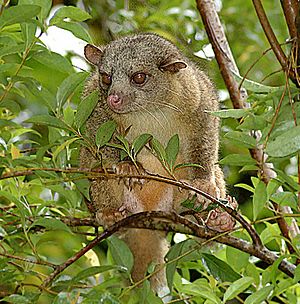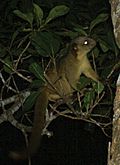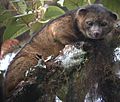Bassaricyon facts for kids
Quick facts for kids Bassaricyon |
|
|---|---|
 |
|
| Northern olingo (Bassaricyon gabbii) | |
| Scientific classification |
|
| Kingdom: | Animalia |
| Phylum: | Chordata |
| Class: | Mammalia |
| Order: | Carnivora |
| Family: | Procyonidae |
| Genus: | Bassaricyon Allen, 1876 |
| Species | |
|
|
Olingos are small, furry animals that live in the rainforests of Central and South America. They are part of the raccoon family, also known as procyonids. You can find them from Nicaragua all the way down to Peru.
These animals spend most of their lives in trees, which means they are "arboreal." They are also "nocturnal," meaning they are active at night and sleep during the day. Olingos can live in many different places, from areas near the sea up to high mountains, about 2,750 meters (9,000 feet) above sea level.
Olingos look a lot like another animal called a kinkajou. However, there are some differences: olingos don't have tails that can grab things (called "prehensile tails"), and their tongues don't stick out very far. They also have longer noses and special scent glands near their bottom. Even though they look similar, olingos and kinkajous are not closely related. Olingos also look a bit like galagos and some types of lemurs.
Types of Olingos
Scientists don't always agree on how many different types, or species, of olingos there are. Some think there are as many as five species, while others believe there are only two or even just one! For a long time, only the northern olingo (Bassaricyon gabbii) was well-known.
It's quite rare to see olingos in zoos. When they are there, people sometimes mistake them for kinkajous because they look so similar.
Discovering the Olinguito
In 2006, a scientist named Kristofer Helgen found a new type of olingo in the Andes mountains of Ecuador. It was similar to Bassaricyon alleni but clearly different. He named this new species Bassaricyon neblina, which is now commonly called the Olinguito. He shared his exciting discovery on August 15, 2013.
After studying their bodies, measurements, DNA, and where they live, Helgen and his team confirmed that there are four main species of olingos:
| Image | Scientific Name | Common Name | Where They Live |
|---|---|---|---|
 |
Bassaricyon alleni | Eastern lowland olingo | Lowlands of Guyana, Venezuela, and in Colombia, Ecuador, Peru and Bolivia east of the Andes mountains. |
 |
Bassaricyon gabbii | Northern olingo | Lowlands and highlands of Nicaragua, Costa Rica, and western Panama in Central America. |
 |
Bassaricyon medius | Western lowland olingo | Lowlands of Panama and in Colombia and Ecuador west of the Andes mountains. |
 |
Bassaricyon neblina | Olinguito | Lives only in the "cloud forests" (a type of rainforest) in the Andes mountains of Colombia and Ecuador. |
How Olingos Evolved
Genetic studies, which look at the DNA of animals, show that olingos are most closely related to coatis. Coatis are another type of animal in the raccoon family. Olingos and coatis separated into different groups about 10.2 million years ago. Kinkajous, on the other hand, split off from other raccoon-like animals much earlier, about 22.6 million years ago.
This means that even though olingos and kinkajous look alike, they evolved their similar features separately. This is called "convergent evolution," where different animals develop similar traits because they live in similar environments or have similar lifestyles.
The different types of olingos started to become distinct species about 3.5 million years ago. The Olinguito (B. neblina) was the first to branch off from the others. Then, the northern olingo (B. gabbii) separated about 1.8 million years ago. Finally, the two lowland species, B. alleni and B. medius, became separate about 1.3 million years ago.
Scientists believe that olingos first came to South America from Central America a long time ago. This was part of a big event called the Great American Interchange, when many animals moved between North and South America. The way olingos evolved is different from how kinkajous evolved. Kinkajous are a much older group of animals and are thought to have developed in Central America before they ever reached South America.
| Bassaricyon |
|
|||||||||||||||||||||
See also
 In Spanish: Olingos para niños
In Spanish: Olingos para niños

